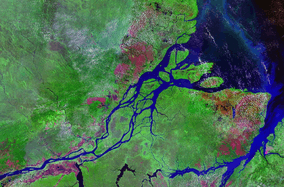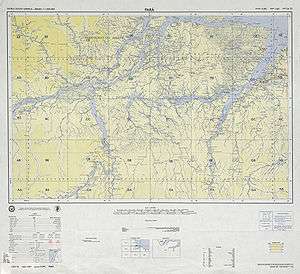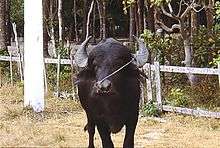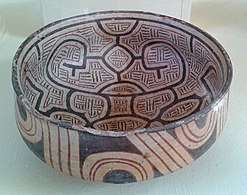Marajó
Marajó (Portuguese pronunciation: [maɾaˈʒɔ]) is a large delta island in the state of Pará,[1] Brazil. It is the main and largest of the islands in the Marajó Archipelago. The island is bordered by the mouth of the Amazon River to the west and northwest, the Atlantic Ocean to the northeast and by the Pará River, a distributary of the Amazon to the east.
 A satellite view of Marajó | |
 Marajó | |
| Geography | |
|---|---|
| Location | Amazon River |
| Coordinates | 0°59′S 49°35′W |
| Archipelago | Marajó Archipelago |
| Area | 40,100 km2 (15,500 sq mi) |
| Area rank | 35th |
| Length | 297 km (184.5 mi) |
| Width | 204 km (126.8 mi) |
| Highest elevation | 40 m (130 ft) |
| Highest point | Breves (city) |
| Administration | |
| State | Pará |
| Macroregion | Marajó |
| Largest settlement | Breves (pop. 99,223) |
| Demographics | |
| Population | 383,336 (2014) |
From approximately 400 BC to 1600 AD, Marajó was the site of an advanced Pre-Columbian society called the Marajoara culture, which may have numbered more than 100,000 people at its peak. Today, the island is known for its large water buffalo population, as well as the pororoca tidal bore periodically exhibited by high tides overcoming the usual complex hydrodynamic interactions in the surrounding reaches of Amazon delta. It is the second-largest island in South America, and the 35th largest island in the world.
With a land area of 40,100 square kilometres (15,500 sq mi) Marajó is comparable in size to Switzerland. Its maximum span is 295 kilometres (183 mi) long and 200 kilometres (120 mi) in perpendicular width.[1]
Geography

The northeastern coastline of Marajó faces the Atlantic Ocean. The outflow from the Amazon between January and July is so great that the sea at the mouth is made up of freshwater for some distance from shore. The city of Belém lies to the south across the southern fork (also called the Pará River) of the river's mouth.[2] The island sits almost directly on the equator.
Together with smaller neighboring islands that are separated from Marajó by rivers, they form the Marajó Archipelago, with an aggregate area of 49,602 square kilometres (19,151 sq mi).[3] The archipelago is contained in the 59,985 square kilometres (23,160 sq mi) Marajó Archipelago Environmental Protection Area, a sustainable-use conservation unit established in 1989 to protect the environment of the delta region.[4]
Large parts of the islands are flooded during the rainy season because of higher water levels of the Amazon River along the coast and heavy rainfall in the interior. Marajó is almost entirely flat. During the rainy season, much of the island becomes flooded as a large lake.[2]
There are 20 large rivers on the island. Because of the changing water levels and regular seasonal flooding, many settlements are built on stilts (Palafitas).
The island is known for the pororoca, a tidal bore phenomenon in the river that creates large waves reaching 4 m (13 ft) in height. It is a tourist destination, especially for surfing of the bore.
Ecology

The eastern side of the island is dominated by savanna vegetation. There are large fazendas with animal husbandry.[2] This is also the location of Lake Arari, which has an area of 400 square kilometres (150 sq mi), but shrinks by 80% during the dry season.[5] There are large herds of domesticated water buffalo, which are technically invasive to the island; they now number about 450,000, higher than the island's human population.[2][6] The western side of the island is characterized by Várzea forests and small farms. Lumber and açaí are produced there.
The island is in the Marajó várzea ecoregion, an area of seasonally and tidally flooded várzea forest.
To the north of the large savanna area are palm swamps, mainly with Buriti Palm (Mauritia flexuosa) and Euterpe oleracea. During the rainy season, the swamps are flooded one meter high. Little is known about the ecology of these swamps.
Municipalities
The most important towns are in the southeastern portion of the island: Soure, Salvaterra, and the largest city, Breves. They feature a basic touristic infrastructure and are popular because of the generous, lightly populated beaches. The city of Soure, on the island's Atlantic coast, serves as an entry point to the island via its ferry link to Belém.
The island is shared by 16 municipalities of three microregions:
- Microregion of Arari:
- Cachoeira do Arari
- Chaves
- Muaná
- Ponta de Pedras
- Salvaterra
- Santa Cruz do Arari
- Soure
- Microregion of Furos de Breves:
- Microregion of Portel:
- Bagre
- Gurupá
- Melgaço
- Portel
History
| |||
The island was the site of an advanced pre-Columbian society, the Marajoara culture, which existed from approximately 400 BC to 1600 AD. The island has been a center of archaeological exploration and scholarship since the nineteenth century.[2] Scholars from the 1980s forward have divided the pre-Columbian period into the Ananatuba phase (c. 1100–c. 200 BC), the Mangueiras phase (c. 1000 BC–c. 100 AD), the Formiga phase (c. 100-400 AD), the Marajoará phase (c. 400-1200 AD), and the Aruã phase (1200-1500 AD).[2]
Since the 1990s, there has been debate over the origins and sophistication of Marajó's pre-Columbian society. Based on fieldwork in the 1940s and 1950s, the archaeologist Betty Meggers initially argued that the Marajoara culture had been founded by emigrants from the Andes and that the society steadily declined until its final collapse at approximately 1400 AD, due to the Marajó's poor soil fertility and other environmental factors. Megger's hypotheses subsequently became associated with environmental determinism. Her theory has since been rejected, however, by the archaeologist Anna Curtenius Roosevelt, who re-excavated Marajó in the 1980s. According to Roosevelt, the Marajoara culture developed independently within the Amazon and featured both intensive subsistence agriculture and major public works.[7]
Roosevelt estimated that Marajó may have had a population of more than 100,000 people at its peak.[8] The population lived in homes with tamped earth floors, organized themselves into matrilineal clans, and divided tasks by sex, age, and skill level.
The arrival of Europeans in the sixteenth century was catastrophic to the indigenous population of the island; 90% died due to high mortality from Eurasian infectious diseases; they lacked immunity against these diseases that had become endemic in European and Asian cities.[9]
In contrast, however, during the 1918–1919 pandemic worldwide of the Spanish influenza, Marajó was the only major populated area not to have any documented cases of the illness.[10]
The island is also the location of the Roman Catholic Territorial Prelature of Marajó.
References
- "Marajó Island". Encyclopædia Britannica. Encyclopædia Britannica Inc. 2014. Retrieved 2014-12-17.
- Araujo Costa, Costa (2014). "Marajó". Grove Art Online. Oxford, UK: Oxford University Press. Retrieved 2014-12-17.
- Development Plan for Marajó, Document of the Government of Brazil Archived July 6, 2011, at the Wayback Machine
- APA Arquipélago do Marajó (in Portuguese), ISA: Instituto Socioambiental, retrieved 2016-06-27
- Prof. "Pará Histórico: Índios no Pará". Parahistorico.blogspot.com. Archived from the original on 2014-05-29. Retrieved 2014-06-23.
- Romero, Simon (2015-06-20). "To Soften Image, Brazilian Police Ride In Atop Horned Beasts". The New York Times. ISSN 0362-4331. Retrieved 2017-05-05.
- Mann, Charles C. (2006-10-10). 1491 (Second Edition): New Revelations of the Americas Before Columbus. Knopf Doubleday Publishing Group. pp. 328–340. ISBN 9780307278180.
- Mann, Charles C. (2006-01-01). 1491: New Revelations of the Americas Before Columbus. Vintage Books. pp. 335. ISBN 9781400032051.
- Lobato, Sidney da Silva (2012). Amapá: experiências fronteiriças. Coleção Estudos Amazônicos. História (in Portuguese) (1a ed.). Belém, Pará: Editora Estudos Amazônicos. pp. 7–8.
- Ryan, Jeffrey, ed. Pandemic influenza: emergency planning and community preparedness. Boca Raton: CRC Press, 2009. p. 24
External links
| Wikimedia Commons has media related to Marajó. |

- Marajó Island and Pará state at V-Brazil.com

